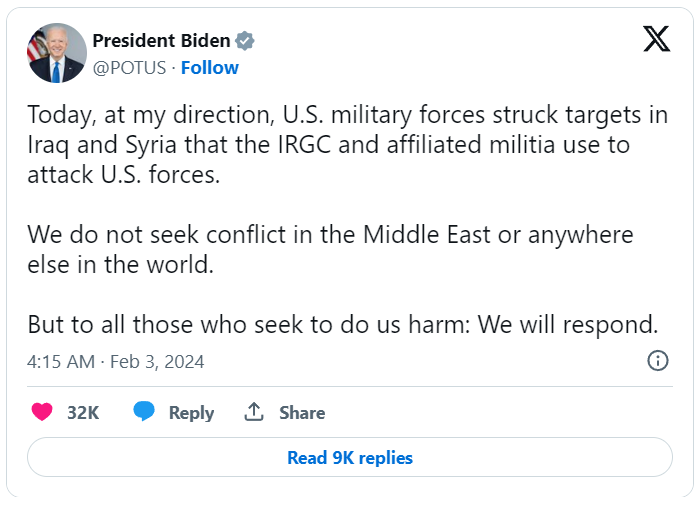In response to a deadly drone attack on an American base in Jordan, the US military initiated retaliatory air strikes against Iranian forces and Tehran-backed militia groups in Iraq and Syria on Friday, resulting in the reported death of at least 18 fighters.
The United States attributed the Sunday drone attack to Iran-backed forces but refrained from targeting Iran’s territory directly. Instead, Washington aimed to deter future attacks while avoiding a full-scale conflict with Tehran, a stance both parties have expressed a desire to avoid.
President Joe Biden stated, “Our response began today. It will continue at times and places of our choosing. The United States does not seek conflict in the Middle East or anywhere else in the world. But let all those who might seek to do us harm know this: If you harm an American, we will respond.”

The air strikes specifically targeted the Islamic Revolutionary Guard Corps Quds Force and “affiliated militia groups.” According to the US Central Command (CENTCOM), American forces engaged in the strikes hit “more than 85 targets, with numerous aircraft, including long-range bombers flown from the United States.” CENTCOM further specified that the airstrikes utilized over 125 precision munitions, targeting command and control centers, intelligence facilities, as well as rocket, missile, and drone storage facilities belonging to militia groups and Iranian forces involved in attacks against US and coalition forces.

U.S. Airstrikes Result in at Least 18 Casualties Among Pro-Iran Fighters, Prompting Concerns of Escalation
The recent US airstrikes targeting Iranian-backed forces in Syria and Iraq have reportedly led to the death of at least 18 pro-Iran fighters, according to the Syrian Observatory for Human Rights war monitor.
National Security Council spokesperson John Kirby informed journalists that the airstrikes, conducted by B-1 bombers flying from the United States, lasted approximately 30 minutes. Despite the extensive distance covered by the bombers, the Defense Department is still evaluating the damage caused by the strikes. Kirby emphasized that the United States views the raids as successful and hinted at the possibility of additional actions.
Rami Abdel Rahman, the chief of the Syrian Observatory for Human Rights, stated that the airstrikes in Syria resulted in the destruction of at least 26 major sites housing pro-Iranian groups, including weapons depots. Additionally, sources from Iraq reported that a weapons warehouse and a command center of pro-Iranian groups were targeted in western Iraq along the Syrian border, causing at least “some injuries,” according to two Iraq security sources.
The airstrikes are seen as a “significant escalation,” noted Allison McManus, managing director for national security and international policy at the Center for American Progress. However, she expressed skepticism about their impact, stating, “We have not seen that similar tit-for-tat strikes have had a deterrent effect.”
The Iraqi government, which previously called for the departure of international troops after a US strike in Baghdad, condemned the recent military action as a violation of its sovereignty.
Read Latest Updated News: EU’s €50B Lifeline: Support Soars for Ukraine
Biden Attends Solemn Ceremony for Soldiers Killed in Jordan Drone Attack as U.S. Conducts Strikes in Response
National Security Council spokesperson John Kirby confirmed that the US government informed the Iraqi government prior to the recent airstrikes, although he did not provide details about Baghdad’s response.
President Joe Biden, who had pledged to retaliate against those responsible for the drone attack in Jordan, participated in a solemn military ritual at a Delaware air base for the dignified transfer of the three deceased soldiers on Friday. Secretary of Defense Lloyd Austin and Chairman of the Joint Chiefs of Staff General CQ Brown also attended the ceremony, underscoring the significance of returning fallen service members, particularly in the aftermath of the US withdrawal from Afghanistan in 2021.
The three soldiers killed in the Sunday attack marked the first US military deaths from hostile fire in the Middle East since the October 7 Hamas surprise attack on Israel. This event triggered a significant Israeli offensive in Gaza, escalating tensions and violence in the region and bringing it perilously close to a full-scale conflict.
Since mid-October, US and coalition troops have faced over 165 attacks in Iraq, Syria, and Jordan, involving drones, rockets, and short-range ballistic missiles. Many of these attacks, attributed to a loose alliance of Iran-linked armed groups opposing US support for Israel in the Gaza conflict, aim to push American forces out of the region. Numerous incidents have resulted in injuries to American personnel.
In parallel developments, Yemen’s Iran-backed Huthi rebels began targeting international shipping in November, prompting US and British air strikes to diminish their capability to attack commercial vessels. Additionally, two SEALS, elite special forces in the US military, were declared dead after being lost at sea during an operation to seize Iranian weapons bound for the Huthis on a ship off the coast of Somalia.
Explore the diverse world of U.S. military aircraft in our comprehensive guide, covering everything from fighter jets to transport planes.













